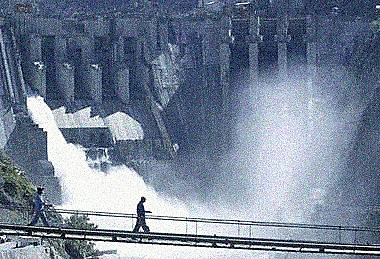 “Every now and again, one reads an editorial that stops the reader in his tracks,” writes John Daly at Oil Price. He’s referring to a story titled “War Inevitable To Tackle Indian Water Aggression” on Pakistan’s Urdu-language widely read daily newspaper Nawa-e Waqt, which “bluntly commented on India’s Kashmiri water polices and Islamabad’s failure up to now to stop New Delhi’s efforts to construct hydroelectric dams in Kashmir.”
“Every now and again, one reads an editorial that stops the reader in his tracks,” writes John Daly at Oil Price. He’s referring to a story titled “War Inevitable To Tackle Indian Water Aggression” on Pakistan’s Urdu-language widely read daily newspaper Nawa-e Waqt, which “bluntly commented on India’s Kashmiri water polices and Islamabad’s failure up to now to stop New Delhi’s efforts to construct hydroelectric dams in Kashmir.”
First some background on the tug of the war over the Indus, a prime water source for Pakistan. Almost 2,000 miles long, its wellspring is in the Tibetan plateau, which incorporates the Himalayas. The Indus runs through Kashmir (and Jammu) and flows south through Pakistan to Karachi where it empties into the Arabian Sea. But the dams that India builds across rivers feeding into the Indus not only decrease the share of water for Pakistan but can be used to deprive Pakistan of even more water in the event of war.
To address this issue, in 1960 India and Pakistan signed the Indus Waters Treaty, which gave India control of the main rivers of the Punjab, and Pakistan control of the Indus. Recently, though, wrote Tufail Ahmad for the Henry Jackson Society in 2009, “Concern is growing in Pakistan that India is controlling the water flow of rivers that flow from India into Pakistan, especially the Indus, Chenab and Jhelum rivers that pass through India’s Jammu & Kashmir state.”
Pakistani commentators, pressure groups and religious leaders think that India is controlling the river waters to strangulate Pakistani agriculture, which could affect Pakistani exports and increase its dependency on food imports. Pakistani commentators fear future war with India may break out over water disputes.
This is hardly the first time that Pakistan voices have called for war over water issues. Ahmad writes about how in
… early 2008, an editorial in the [Pakistani] newspaper Roznama Ausaf accused India of planning a “Water Bomb” strategy to strangle Pakistan economically. The article quoted the officials of the IBWC pressure group [Pakistan’s Indus Basin Water Council] as saying that India wants to achieve through a “water bomb” what it could not achieve through the three wars waged over the past six decades.
He then sheds light on the meaning of the phrase “water bomb.”
Noting that India is planning “50 dams to raid the waters of the rivers” flowing into Pakistan, the IBWC warned: “If this is not foiled, Pakistan will face the worst famine and economic disaster.”
Daly quotes the Nawa-e Waqt editorial on how to counter the water bomb.
India should be forcibly prevented from constructing these dams. If it fails to constrain itself, we should not hesitate in launching nuclear war because there is no solution except this.
That, too, is an old refrain in Pakistan. Ahmad again.
In May 2009, [IBWC Chairman Hafiz Zahoorul Hassan] Dahir described “India’s water terrorism as a bigger threat than Talibani terrorism,” and then added: “The day is not far when circumstances like those in Somalia, Ethiopia and Chad will emerge inside Pakistan… India has readied a weapon for use against Pakistan that is more dangerous and destructive than an atomic bomb.” … [A] convener of the Pakistani chapter of the Kashmiri secessionist organizations’ alliance, Syed Yousaf Naseem stated. … “Unless this issue is resolved, the Damocles’ sword of a nuclear clash will remain hanging over the region.”
The rhetoric is as flamboyant as it is incendiary — and irresponsible to the power of ten megatons. In a 2007 paper for the Physicians for Social Responsibility titled An Assessment of the Extent of Projected Global Famine Resulting From Limited, Regional Nuclear War, Ira Helfand, MD, writes that nuclear war in the region would result in “a total global death toll in the range of one billion from starvation alone.”
An atmospheric scientist from the University of Colorado in Boulder, Brian Toon helped Carl Sagan put nuclear winter on the map. Colorado Arts & Sciences magazine reports:
In 2006, Toon helped lead two studies that found that even a small-scale nuclear war—one involving 100 15-kiloton explosions—could slaughter as many people as were killed during World War II and disrupt the world’s climate (and food production) for a decade. … Pakistan and India have the capacity to detonate 50 Hiroshima-sized nuclear bombs.
Daly wonders aloud if “there any way out before the missiles fly?” Ahmad wrote, “There is a realization in Pakistan that the 1960 Indus Water Treaty that establishes legal framework for use of river waters has been to the advantage of India.” But Daly writes:
The 1960 Indus Water Treaty. … is considered one of the world’s most successful trans-boundary water treaties, as it addresses specific water allocation issues and provides unique design requirements for run-of-the-river dams … All foreign governments interested in avoiding further military conflict in South Asia should impress upon both New Delhi and Islamabad the ongoing value of their 51 year-old water agreement and urge them to resolve their conflicts within its framework.

